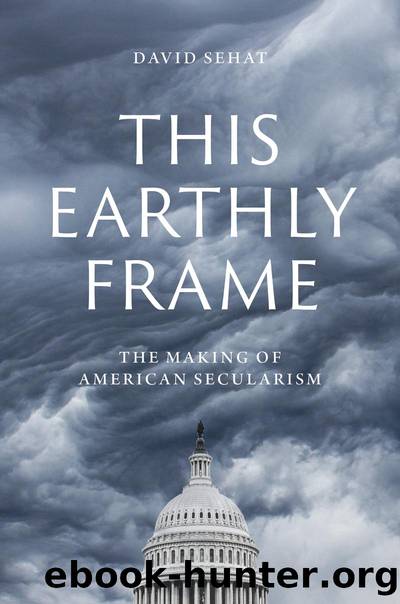This Earthly Frame: The Making of American Secularism by David Sehat

Author:David Sehat [Sehat, David]
Language: eng
Format: epub
Tags: Religion, General
ISBN: 9780300244212
Google: LZZXEAAAQBAJ
Publisher: YaleUP
Published: 2022-09-15T21:51:39+00:00
CHAPTER SEVEN
The Death of God
T
hese developmentsâthe growing assertiveness of civil society groups, the rising prominence of sectarian rivalry, the maturation of the courtâs rights revolution, and the growing impulse toward inclusion and toward liberalismâwere a beginning, not an end. Part of the dilemma was the political philosophy expressed by the Supreme Court. Prior to midcentury many people had operated with the vague sense, as the Harvard political scientist V. O. Key put it in 1942, âthat the government is identical with the mass of the population and that by some mysterious process the âwill of the peopleâ is translated into governmental decision and thereby people ârule themselves.âââ1
In fact, as the conflict at midcentury showed, society was composed of groups. Politics consisted primarily of group conflict. Policy emerged from disagreement, bargaining, and consensus among groups who, individually, could muster only a plurality within American society. But when several groups worked together, they were able to achieve a stable governing alliance in American life. This is known as the pluralist conception of politics.2
The court on some level recognized the political reality and saw itself as part of a pluralistic social and political process. When groups engaged in litigation, they were using suits, the court said in 1963, as âa form of political expression.â âGroups which find themselves unable to achieve their objectives through the ballot frequently turn to the courts,â it continued. âUnder the conditions of modern government, litigation may well be the sole practicable avenue open to a minority to petition for redress of grievances.â As a result, the court became a principal place for minorities, religious or otherwise, to be recognized in American public life.3
But the dilemma of pluralism was about to be faced by more than just the court, in part because the political developments of the sixties forced a confrontation with the scale and scope of American multiplicity that had hitherto been unimaginable. It turned out that midcentury conceptions of diversity were too narrow, which accounted for the justicesâ continued surprise as groups appeared before them with a bewildering number of affirmations. The narrow conception of diversity that animated pluralist politics left many people on the margins of American life, struggling to find ways into the public debate.
Those other groups soon began to muscle their way more fully into public political consciousness to decenter white Christian conceptions of the United States. The process had already begun in 1955 with the start of the civil rights movement, though initially the movement posed no real challenge to the public role of American Christianity. Movement leaders were mainly ministers who spoke the language of theology and who called on the American public to embrace black rights as a matter of Christian religious interest. For white Christian groups, who viewed themselves as guardians of American public culture, the religious language of the early civil rights movement was merely an invitation to extend their custodianship to the acquisition of black rights. It advanced pluralist politics while keeping Christian religious prerogatives in place.4
By 1960, though, the cultural and social dynamics that structured the era would take a turn.
Download
This site does not store any files on its server. We only index and link to content provided by other sites. Please contact the content providers to delete copyright contents if any and email us, we'll remove relevant links or contents immediately.
| Buddhism | Christianity |
| Ethnic & Tribal | General |
| Hinduism | Islam |
| Judaism | New Age, Mythology & Occult |
| Religion, Politics & State |
Cecilia; Or, Memoirs of an Heiress — Volume 1 by Fanny Burney(32434)
Cecilia; Or, Memoirs of an Heiress — Volume 2 by Fanny Burney(31868)
Cecilia; Or, Memoirs of an Heiress — Volume 3 by Fanny Burney(31852)
The Secret History by Donna Tartt(18840)
Sapiens: A Brief History of Humankind by Yuval Noah Harari(14247)
Leonardo da Vinci by Walter Isaacson(13179)
The Radium Girls by Kate Moore(11921)
Sapiens by Yuval Noah Harari(5293)
How Democracies Die by Steven Levitsky & Daniel Ziblatt(5127)
The Wind in My Hair by Masih Alinejad(5033)
Homo Deus: A Brief History of Tomorrow by Yuval Noah Harari(4822)
Endurance: Shackleton's Incredible Voyage by Alfred Lansing(4676)
The Silk Roads by Peter Frankopan(4456)
Man's Search for Meaning by Viktor Frankl(4420)
Millionaire: The Philanderer, Gambler, and Duelist Who Invented Modern Finance by Janet Gleeson(4374)
The Rape of Nanking by Iris Chang(4136)
Joan of Arc by Mary Gordon(4013)
The Motorcycle Diaries by Ernesto Che Guevara(4009)
Hitler in Los Angeles by Steven J. Ross(3900)
